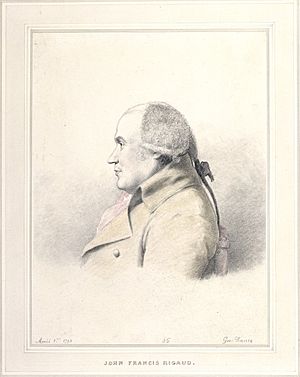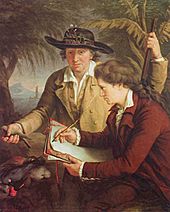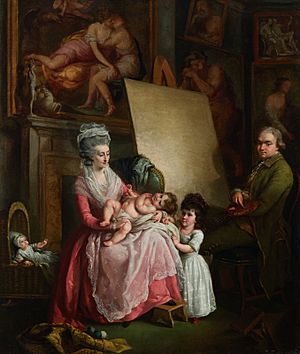John Francis Rigaud facts for kids

John Francis Rigaud (born May 18, 1742 – died December 6, 1810) was a famous painter from the 1700s. He painted many different things. These included historical scenes, portraits of people, and decorations for buildings. He was born in Turin, Italy, but his family was originally from France. Most of his life as an artist was spent in England.
Contents
A Young Artist's Journey
John Francis Rigaud was born in Turin, Italy, on May 18, 1742. His family had a interesting history. His grandfather, Jacques Dutilh, was a Protestant merchant. He had to leave Lyon, France, with his family. This was because of a law change called the revocation of the Edict of Nantes. Sadly, Jacques died during their journey. His wife then started using her maiden name, Rigaud. This is how the family became known by that name.
John showed a talent for art from a young age. He began studying painting with Claudio Francesco Beaumont in Turin. Beaumont was a historical painter for the king of Sardinia. Rigaud later left Turin to travel and learn more about art.
Studying Art in Italy
He traveled to many Italian cities to study painting. These included Florence and Bologna. In 1766, he became a member of the Accademia Clementina in Bologna. He then went to Rome, but had to return home for a short time.
In 1768, he set off again to explore more of Italy. He visited Piacenza, Parma, and Bologna once more. Finally, he settled in Rome. There, he spent his time studying the works of famous old artists. He also attended life-drawing classes to improve his skills. During this time, he created a very important painting called Hercules Resting from his Labours. In Rome, he made friends with other artists, like sculptor Johan Tobias Sergel and painter James Barry.
Life and Work in London
In April 1770, Rigaud traveled with his friend James Barry through Florence, Bologna, and Turin. He then spent a short time in Paris. In December 1771, he moved to London, England.
Joining the Royal Academy
In 1772, Rigaud showed his painting Hercules at the Royal Academy in London. He was quickly chosen to be an associate member of the Academy that same year. He continued to show many of his paintings at the Royal Academy. Between 1772 and 1815, he displayed a total of 155 artworks there.
Decorating Grand Homes
While he exhibited many paintings, Rigaud's most profitable work was decorating grand homes. He painted for wealthy families, including Lord Gower and Lord Sefton. Some of his Royal Academy exhibits were actually studies for large ceiling paintings. In 1797, he even showed examples of his fresco painting on stone.
The famous architect William Chambers hired him for projects in London. Rigaud helped decorate Melbourne House (1772 and 1774) and Somerset House (1780). He also helped decorate parts of the Guildhall (1794) and Trinity House (1796). His decorative works often featured classical figures and looked like ancient carvings.
Other Paintings
Rigaud also created history paintings. One example is Entry of the Black Prince into London with his Royal Prisoner (1775). He painted several works for art galleries, including the Boydell Shakespeare Gallery in the late 1780s.
He also painted religious scenes. In 1780, he created a Descent from the Cross for a Catholic chapel in London. This painting can now be seen in the Church of St Anselm and St Cecilia. In 1797, he painted a fresco of the Ascension for a newly rebuilt church. However, this painting did not last long and was removed in 1827.
Painting Portraits
Rigaud was also a skilled portrait painter. In 1777, he painted a group portrait of artists Francesco Bartolozzi, Agostino Carlini, and Giovanni Battista Cipriani. In 1782, he painted another group portrait of Sir Joshua Reynolds, Sir William Chambers, and Joseph Wilton. He also painted a series of portraits of naval heroes, including Lord Nelson. His portraits were known for being strong and sometimes a bit unusual.
In 1784, Rigaud was officially elected to the Royal Academy. His painting Samson Breaking his Bands was his special diploma work for this honor. In 1795, he was named a historical painter to the king of Sweden. He also became a member of the Royal Swedish Academy of Arts. After 1800, his painting career seemed to slow down. He translated Leonardo da Vinci's book A Treatise on Painting in 1802. He also helped restore old painted decorations in places like Greenwich Hospital.
Family Life
John Francis Rigaud married Mary Williams on July 21, 1774. They had three daughters and one son. Their son, Stephen Francis Dutilh Rigaud, also became a painter. After his wife passed away in 1808, Rigaud lived with his son.
Later Years and Passing
John Francis Rigaud died on December 6, 1810. He passed away at Packington Hall in Warwickshire. He was buried in St James' Church, Great Packington.



